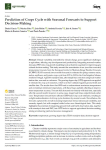Garcia D., Silva N., Rolim J., Ferreira A., Santos J.A., Cameira M.D., Paredes P. (2025). Prediction of crops cycle with seasonal forecasts to support decision-making. Agronomy, 01/06/2025, vol. 15, n. 6, p. 1291.
http://doi.org/10.3390/agronomy15061291
http://doi.org/10.3390/agronomy15061291
| Titre : | Prediction of crops cycle with seasonal forecasts to support decision-making (2025) |
| Auteurs : | D. Garcia ; N. Silva ; J. Rolim ; A. Ferreira ; J.A. Santos ; M.D. Cameira ; P. Paredes |
| Type de document : | Article |
| Dans : | Agronomy (vol. 15, n. 6, June 2025) |
| Article en page(s) : | p. 1291 |
| Langues : | Anglais |
| Langues du résumé : | Anglais |
| Catégories : |
Catégories principales 06 - AGRICULTURE. FORÊTS. PÊCHES ; 6.1 - Généralités. Situation AgricoleThésaurus IAMM AIDE A LA DECISION ; PREVISION METEOROLOGIQUE ; CLIMAT ; CHANGEMENT CLIMATIQUE ; MODELE |
| Résumé : | Climate variability, intensified by climate change, poses significant challenges to agriculture, affecting crop development and productivity. Integrating seasonal weather forecasts (SWF) into crop growth modelling tools is therefore essential for improving agricultural decision-making. This study assessed the uncertainties of raw (non-bias-corrected) temperature forecasts from the European Centre for Medium-Range Weather Forecasts (ECMWF) SEAS5 seasonal (seven-month forecasts) to estimate the spring-summer maize, melon, sunflower, and tomato crops cycle from 2013 to 2022 in the Caia Irrigation Scheme, southern Portugal. AgERA5 reanalysis data, after simple bias correction using local weather station data, was used as a reference. The growing degree-day (GDD) approach was applied to estimate the crop cycle duration, which was then validated against ground truth and satellite data. The results show that SWF tend to underestimate maximum temperatures and overestimate minimum temperatures, with these biases partially offsetting to improve mean temperature accuracy. Forecast skill decreased non-linearly with lead time, especially after the second month; however, in some cases, longer lead times outperformed earlier ones. Temperature forecast biases affected GDD-based crop cycle estimates, resulting in a slight underestimation of all crop cycle durations by around a week. Nevertheless, the forecasts captured the overall increasing temperature trend, interannual variability, and anomaly signals, but with marginal added value over climatological data. This study highlights the potential of integrating ground truth and Earth observation data, together with reanalysis data and SWF, into GDD tools to support agricultural decision-making, aiming at enhancing yield and resources management. |
| Cote : | En ligne |
| URL / DOI : | http://doi.org/10.3390/agronomy15061291 |







